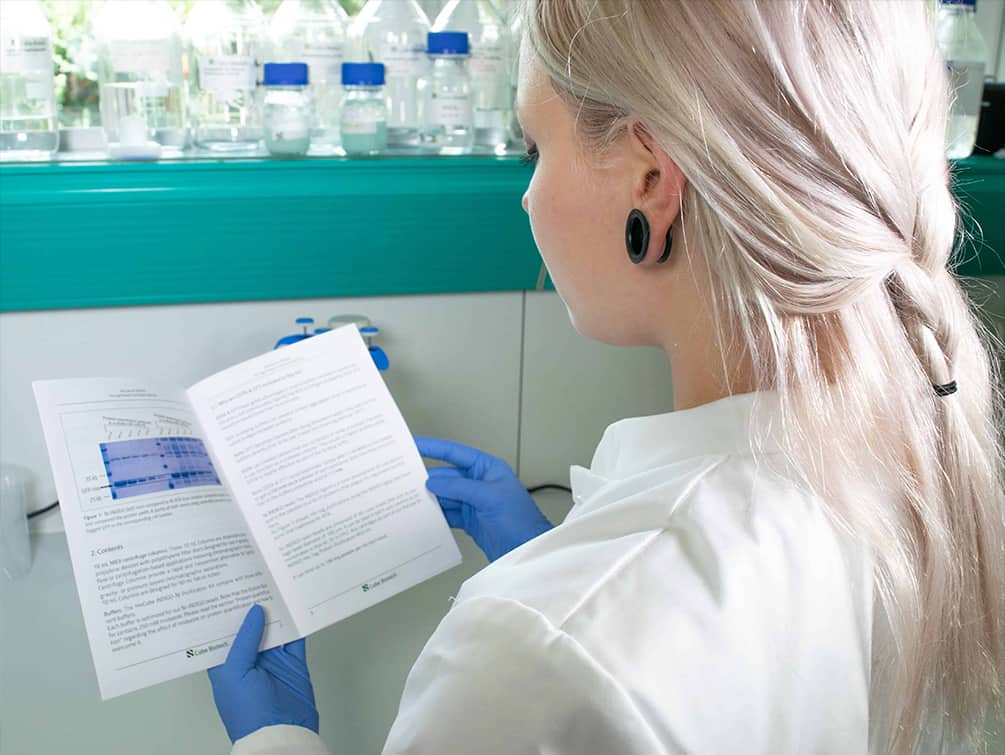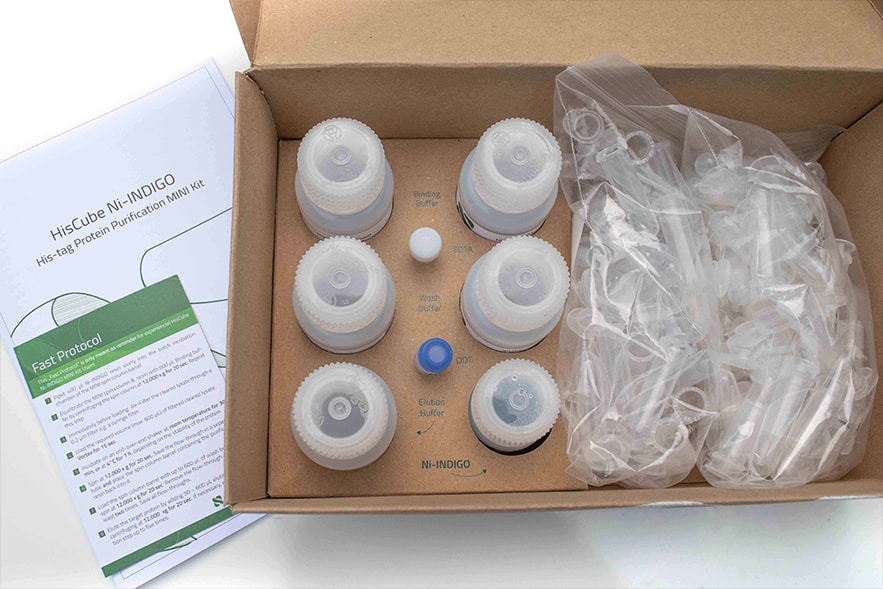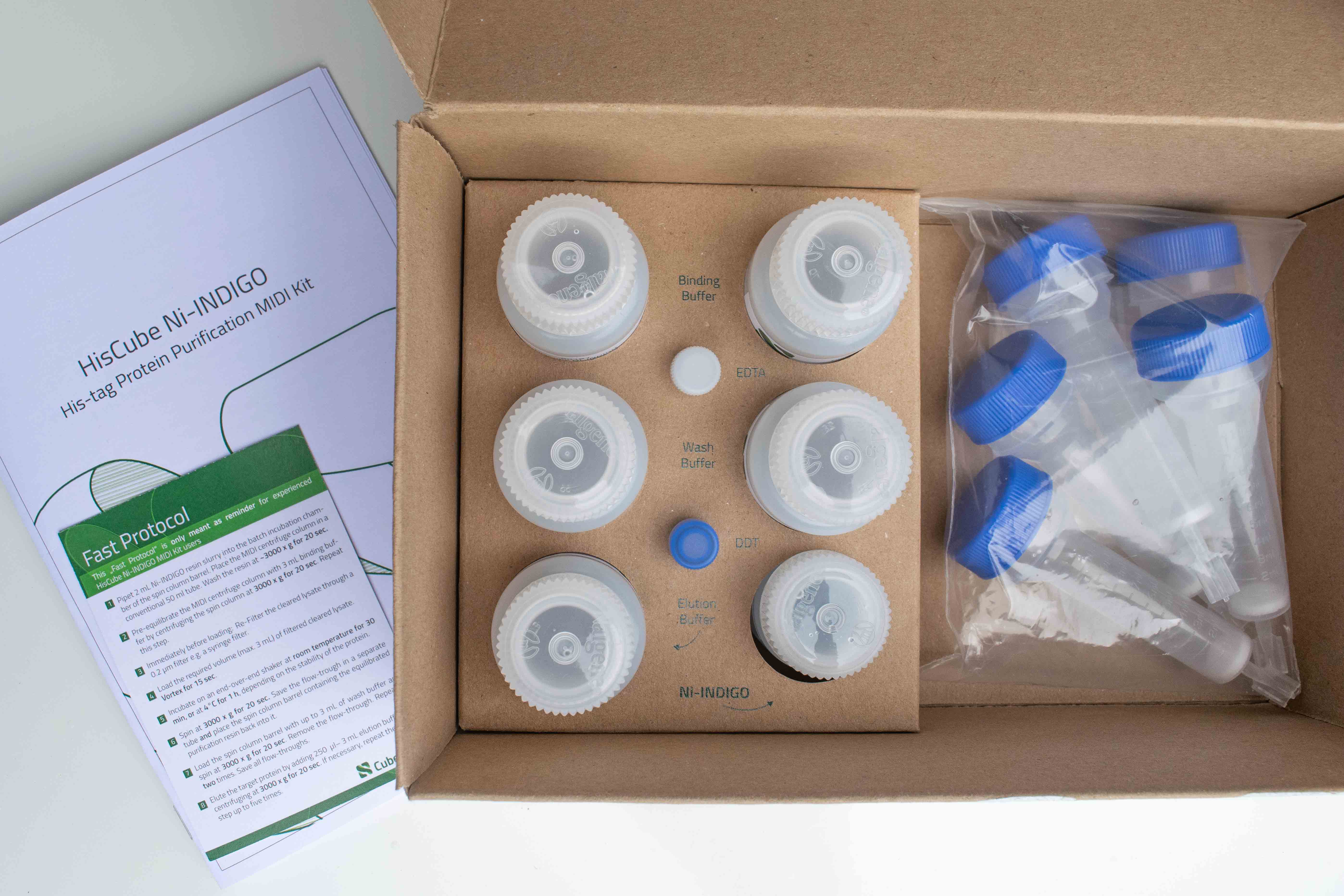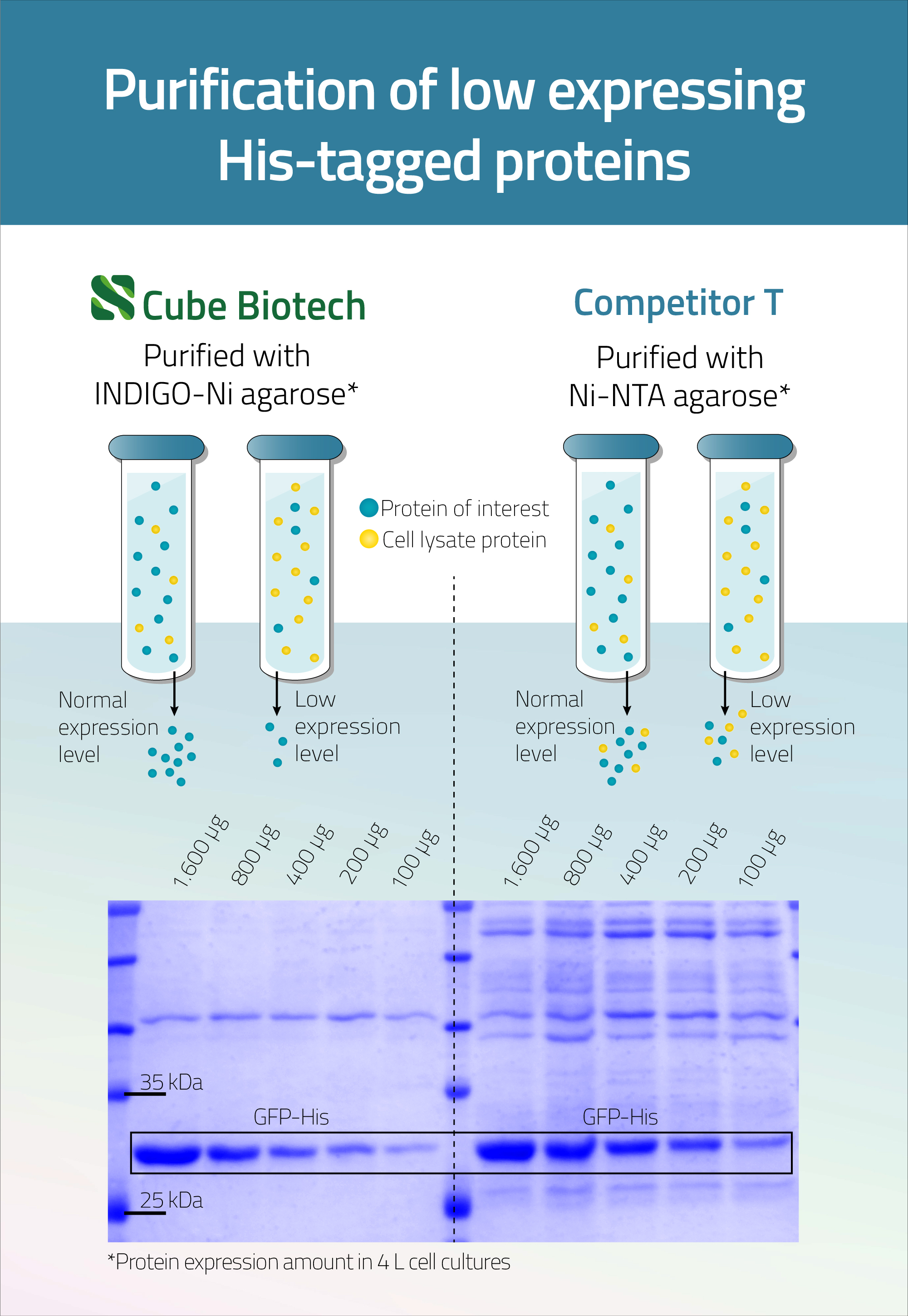.jpg)
HisCube Ni-INDIGO His-tag protein purification MINI and MIDI Kits
1. What are the HisCube Kits
2. Contents of the Kit
3. Features of the components
4. The INDIGO ligand
5. Order the HisCube Purification Kits
Cube Biotech is proud to announce the launch of our first protein purification Kits. Using our in-house developed INDIGO ligand we ensure you that you have the best purification conditions possible.



What are the HisCube Kits?
Our HisCube Ni-INDIGO His-tag protein purification MIDI and MINI Kits were created for the purpose of protein purification of His-tagged proteins from any kind of cell lysate or in vitro expression systems. As experts for protein purification of all kinds our R&D Team asks themselves two questions.
The first answer is: Binding Buffer, Washing Buffer, Elution Buffer combined with matching columns. These columns may either be batch spin columns for a centrifuge (MINI Kit) and MIDI-sized columns that can be used in a centrifuge or work as drip columns too.
The second answer comes along with the first.
The third question proved to be a little bit more work. As the limits of the NTA/IDA ligands had to be overcome.
- Which components of a purification Kit are essential for proper protein purification?
- How can the process of His-tag protein purification be simplified?
- What limits traditional Ni-NTA purification systems and how can these limitations be overcome?
The first answer is: Binding Buffer, Washing Buffer, Elution Buffer combined with matching columns. These columns may either be batch spin columns for a centrifuge (MINI Kit) and MIDI-sized columns that can be used in a centrifuge or work as drip columns too.
The second answer comes along with the first.
The third question proved to be a little bit more work. As the limits of the NTA/IDA ligands had to be overcome.

Contents of the MINI and MIDI Kits
| HisCube Ni-INDIGO His-tag Protein Purification Kits | |
|---|---|
| MINI Kit | MIDI Kit |
 |
 |
|
Contents:
|
Contents:
|
Features of the MINI and MIDI Kits
There are two main components in our HisCube Kits: The Ni-INDIGO resin and the MINI/MIDI columns. Depending on your preferences here you may need a table centrifuge to perform your desired His-tag protein purifications. For the MINI Kit, the centrifuge is essential. The Columns of the MIDI Kit can optionally also be used as drip columns in case no matching centrifuge is available.
The table on the left lists the features of the Ni-INDIGO resin while the tables below show the features of the columns used in the individual Kits.
The table on the left lists the features of the Ni-INDIGO resin while the tables below show the features of the columns used in the individual Kits.
| Usage | Specific binding and purification of 6x His-tagged proteins |
| Specifity | Affinity to His-tagged proteins |
| Binding capacity | 100 mg/mL |
| Chelator Stability | Stable in buffer containing 20 mM DTT and 20 mM EDTA |
| pH tolerance | 2-13 |
| Bead size | 100 μm |
| Bead Ligand | INDIGO |
Features - MINI batch spin columns
| Feature | PureCube 1-step batch Mini |
|---|---|
| Usage | Specific binding and purification of proteins using affinity chromatography and centrifugation |
| Body material | Polypropylene |
| Filter pore size | 0.1-0.2 µm low binding PVDF |
| Max. volume | 600 µL (mini) |
| Max. g force | 12,000-14,000 x g (45-degree fixed angle rotor) |
| Min. g force | 2,500 x g for 1 min |
Features - MIDI Columns
| Feature | PureCube 1-step batch Mini |
|---|---|
| Usage | Specific binding and purification of proteins using affinity chromatography and centrifugation |
| Body material | Polypropylene |
| Filter pore size | 0.1-0.2 µm low binding PVDF |
| Max. volume | 20 mL (midi) |
| Max. g force | 1,500-2,000 x g (swing-bucket rotor) |
| Min. g force | 100-200 x g for 1-10 min |
The INDIGO ligand
Over the years our laboratory team gathered lots of experience in regards to protein purification. During this time the limitations of traditional NTA- and IDA-based purification resins became clear. Foremost their sensitivity to EDTA and DTT. EDTA is often used in mammalian cell buffers to inhibit any proteases that would decrease the protein yield. But also strips the NTA and IDA ligands of their Nickel-ions, thus making the beads useless. DTT on the other hand can be used to dissolve protein aggregates in the cell lysate that might hinder access to the protein's His-tag. But again DTT makes NTA-based beads useless. To counter these problems our R&D Team developed our INDIGO ligand that increases EDTA and DTT tolerance of a His-tag purification procedure up to 20 mM each. One question that may arise from this is how this new INDIGO ligand performs for His-tag purifications. Have a look at figure 1 to see a comparison between Ni-NTA and Ni-INDIGO.

Fig. 1: Overview of INDIGO-Ni agarose resin's purification properties. The immensely superior purity compared to traditional Ni-NTA agarose is worth mentioning. Especially for low-expressing proteins. Left side: The performance of our PureCube 100 INDIGO resin. Right side: Performance of Ni-NTA agarose from competitor T.
For this demonstration, His-tagged GFP was added in known concentrations (see bottom of the blot) to an E.coli cell lysate. This was done to mimic low protein expression rates with different distinct protein concentrations. As it can be seen both Ni-NTA from competitor T and INDIGO-Ni agarose resin purify His-tagged GFP, even at very low concentrations. However, the INDIGO concentration is highly superior in purity.
For this demonstration, His-tagged GFP was added in known concentrations (see bottom of the blot) to an E.coli cell lysate. This was done to mimic low protein expression rates with different distinct protein concentrations. As it can be seen both Ni-NTA from competitor T and INDIGO-Ni agarose resin purify His-tagged GFP, even at very low concentrations. However, the INDIGO concentration is highly superior in purity.


